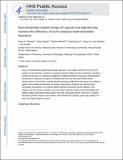| dc.contributor.author | Thomas, Andy | |
| dc.contributor.author | Speck, Klaus | |
| dc.contributor.author | Kevlishvili, Ilia | |
| dc.contributor.author | Lu, Zhaohong | |
| dc.contributor.author | Liu, Peng | |
| dc.contributor.author | Buchwald, Stephen Leffler | |
| dc.date.accessioned | 2020-07-08T19:36:03Z | |
| dc.date.available | 2020-07-08T19:36:03Z | |
| dc.date.issued | 2018-09 | |
| dc.identifier.issn | 1520-5126 | |
| dc.identifier.uri | https://hdl.handle.net/1721.1/126097 | |
| dc.description.abstract | Using a mechanically guided ligand design approach, a new ligand (SEGFAST) for the CuH-catalyzed hydroamination reaction of unactivated terminal olefins has been developed, providing a 62-fold rate increase over reactions compared to DTBM-SEGPHOS, the previous optimal ligand. Combining the respective strengths of computational chemistry and experimental kinetic measurements, we were able to quickly identify potential modifications that lead to more effective ligands, thus avoiding synthesizing and testing a large library of ligands. By optimizing the combination of attractive, noncovalent ligand-substrate interactions and the stability of the catalyst under the reaction conditions, we were able to identify a finely tuned hybrid ligand that greatly enables accelerated hydrocupration rates with unactivated alkenes. Moreover, a modular and robust synthetic sequence was devised, which allowed for the practical, gram-scale synthesis of these novel hybrid ligand structures. | en_US |
| dc.description.sponsorship | NIH Postdoctoral Fellowship Program (grant no. 1F32GM125163) | en_US |
| dc.description.sponsorship | National Academy of Science (grant no. LPDS2017-08) | en_US |
| dc.description.sponsorship | NIH (grant nos. GM122483 and R35GM128779) | en_US |
| dc.language.iso | en | |
| dc.publisher | American Chemical Society (ACS) | en_US |
| dc.relation.isversionof | 10.1021/JACS.8B09565 | en_US |
| dc.rights | Article is made available in accordance with the publisher's policy and may be subject to US copyright law. Please refer to the publisher's site for terms of use. | en_US |
| dc.source | PMC | en_US |
| dc.title | Mechanistically Guided Design of Ligands That Significantly Improve the Efficiency of CuH-Catalyzed Hydroamination Reactions | en_US |
| dc.type | Article | en_US |
| dc.identifier.citation | Thomas, Andy, et al. "Mechanistically Guided Design of Ligands That Significantly Improve the Efficiency of CuH-Catalyzed Hydroamination Reactions." Journal of the American Chemical Society 140, 42 (Sept. 2018): p. 13976-84 doi 10.1021/JACS.8B09565 ©2018 Author(s) | en_US |
| dc.contributor.department | Massachusetts Institute of Technology. Department of Chemistry | en_US |
| dc.relation.journal | Journal of the American Chemical Society | en_US |
| dc.eprint.version | Author's final manuscript | en_US |
| dc.type.uri | http://purl.org/eprint/type/JournalArticle | en_US |
| eprint.status | http://purl.org/eprint/status/PeerReviewed | en_US |
| dc.date.updated | 2019-12-12T19:13:51Z | |
| dspace.date.submission | 2019-12-12T19:13:53Z | |
| mit.journal.volume | 140 | en_US |
| mit.journal.issue | 42 | en_US |
| mit.metadata.status | Complete | |
